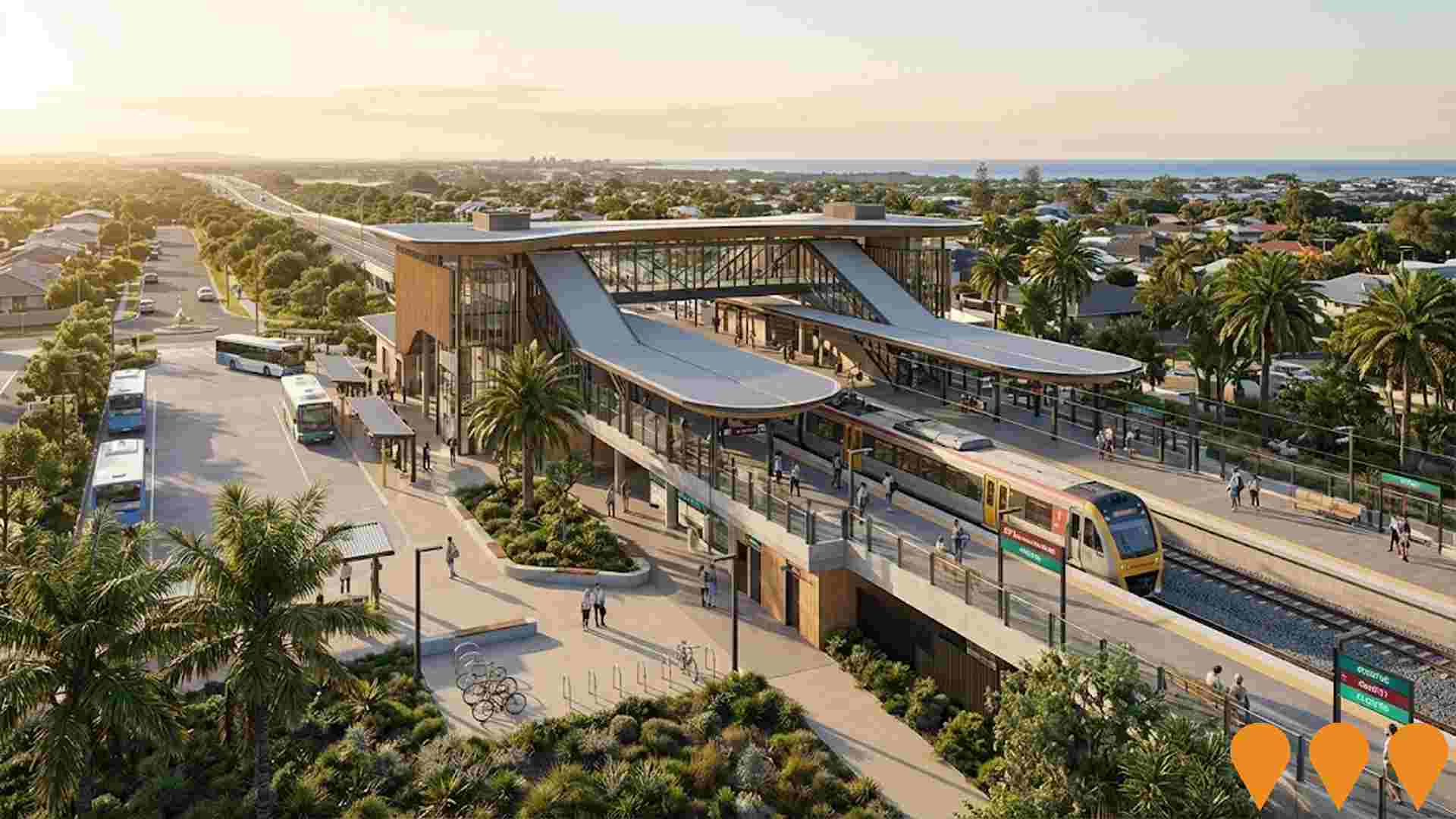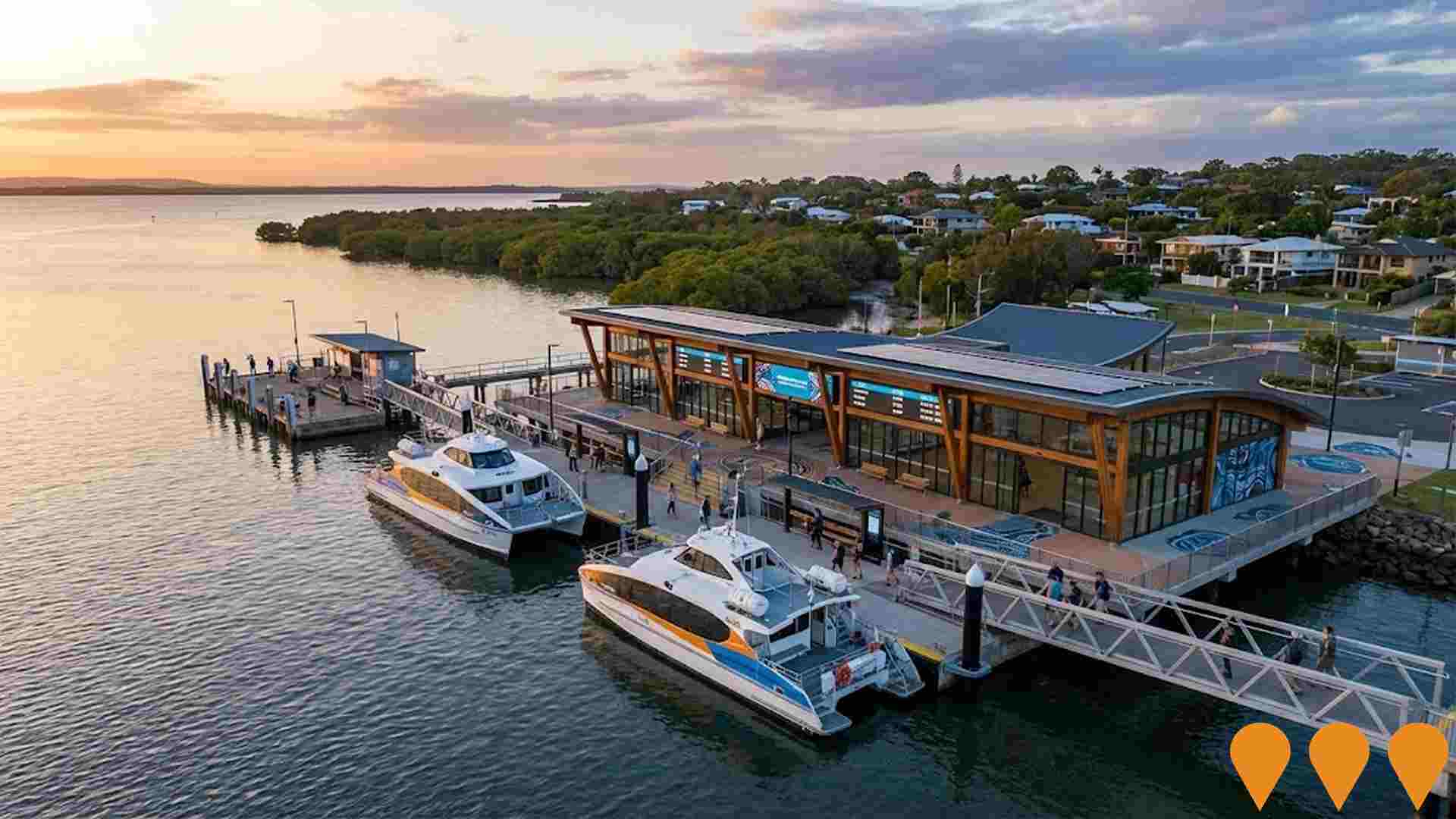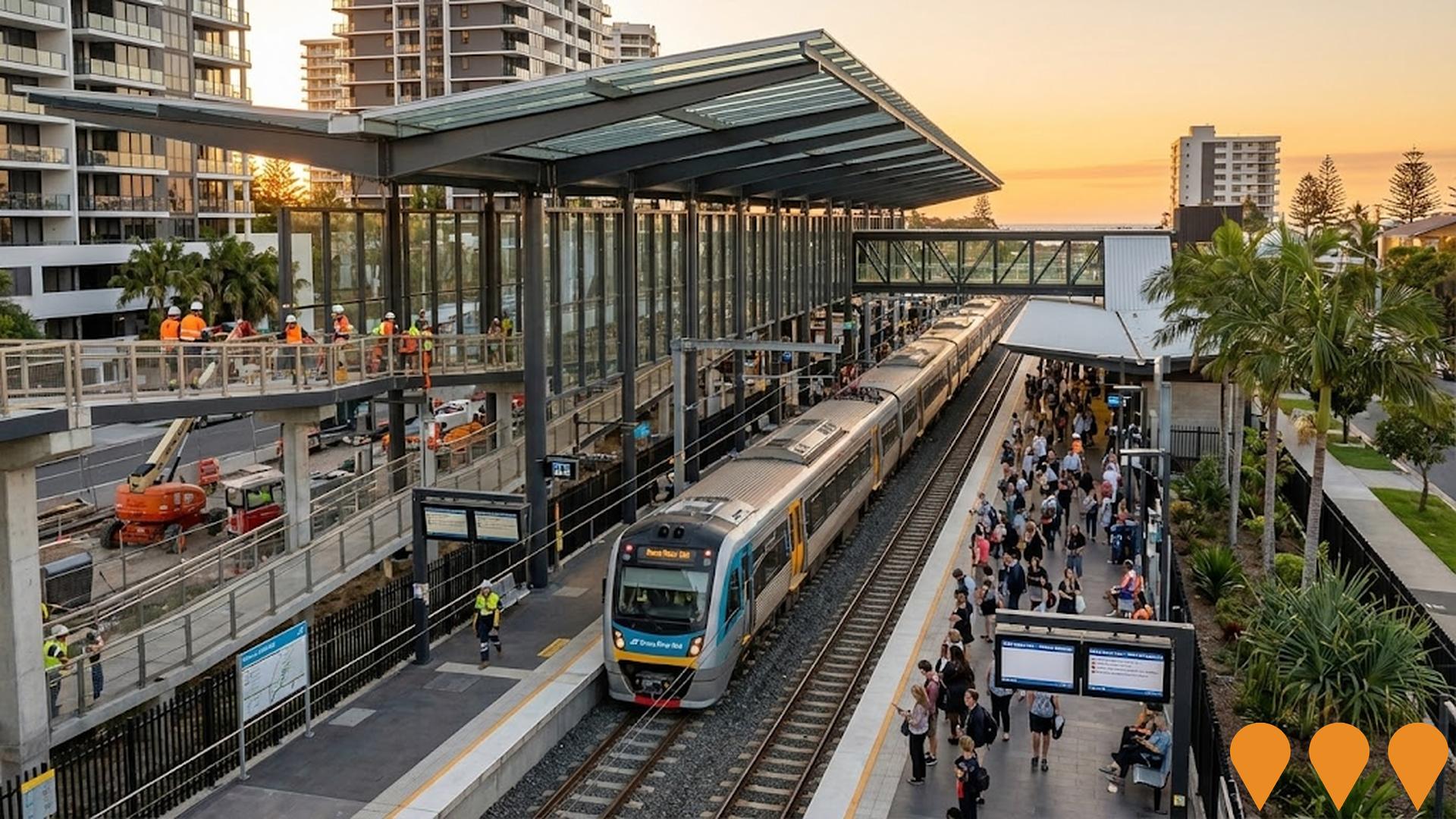Chart Color Schemes
est. as @ -- *
ABS ERP | -- people | --
2021 Census | -- people
Sales Activity
Curious about local property values? Filter the chart to assess the volume and appreciation (including resales) trends and regional comparisons, or scroll to the map below view this information at an individual property level.
Find a Recent Sale
Sales Detail
Population
North Stradbroke Island is positioned among the lower quartile of areas assessed nationally for population growth based on AreaSearch's assessment of recent, and medium term trends
North Stradbroke Island's population is approximately 2,353 as of August 2025. This figure represents an increase of 197 people since the 2021 Census, which reported a population of 2,156 people. The growth was inferred from the estimated resident population of 2,261 in June 2024 and an additional 45 validated new addresses since the Census date. This results in a population density of 8.5 persons per square kilometer. North Stradbroke Island's growth rate of 9.1% since the 2021 census exceeds both the SA4 region (7.6%) and the national average, indicating it as a growth leader. Overseas migration contributed approximately 94.6% of overall population gains during recent periods.
AreaSearch uses ABS/Geoscience Australia projections for each SA2 area released in 2024 with a base year of 2022. For areas not covered by this data and years post-2032, Queensland State Government's SA2 area projections released in 2023 based on 2021 data are adopted. However, these state projections do not provide age category splits, so AreaSearch applies proportional growth weightings in line with ABS Greater Capital Region projections released in 2023 based on 2022 data for each age cohort. According to these projections, the area's population is expected to decline by 57 persons by 2041, while specific age cohorts are anticipated to grow, notably the 75 to 84 age group projected to expand by 162 people.
Frequently Asked Questions - Population
Development
Residential development activity is lower than average in North Stradbroke Island according to AreaSearch's national comparison of local real estate markets
North Stradbroke Island has seen approximately 15 new homes approved annually over the past five financial years, totalling 76 homes. As of FY26, 6 approvals have been recorded. On average, 1.5 new residents per year per dwelling constructed were noted between FY21 and FY25. This suggests a balance between supply and demand, maintaining stable market dynamics.
The average construction value of new properties is $661,000, indicating a focus on the premium market with high-end developments. In FY26, there have been $67,000 in commercial approvals, reflecting the area's residential nature. Compared to Greater Brisbane, North Stradbroke Island shows around 75% of the construction activity per person and ranks among the 60th percentile nationally when assessed areas are considered.
New development consists of 86.0% standalone homes and 14.0% medium and high-density housing, preserving the area's traditional low density character with a focus on family homes appealing to those seeking space. With around 262 people per approval, North Stradbroke Island reflects a transitioning market. Given stable or declining population forecasts, it is expected that North Stradbroke Island may experience less housing pressure in the future, creating favourable conditions for buyers.
Frequently Asked Questions - Development
Infrastructure
North Stradbroke Island has emerging levels of nearby infrastructure activity, ranking in the 22ndth percentile nationally
Four projects identified by AreaSearch may impact the area: Moreton Bay Research Station, Southern Moreton Bay Islands Ferry Terminals Upgrade, Redlands Coast Smart and Connected City Strategy, and Cleveland Line Duplication from Park Road to Cleveland.
Professional plan users can use the search below to filter and access additional projects.
INFRASTRUCTURE SEARCH
 Denotes AI-based impression for illustrative purposes only, not to be taken as definitive under any circumstances. Please follow links and conduct other investigations from the project's source for actual imagery. Developers and project owners wishing us to use original imagery please Contact Us and we will do so.
Denotes AI-based impression for illustrative purposes only, not to be taken as definitive under any circumstances. Please follow links and conduct other investigations from the project's source for actual imagery. Developers and project owners wishing us to use original imagery please Contact Us and we will do so.
Frequently Asked Questions - Infrastructure
Brisbane 2032 Olympic and Paralympic Games Infrastructure Program
The $7.1 billion infrastructure program for the Brisbane 2032 Olympic and Paralympic Games includes a new ~60,000-seat main stadium at Victoria Park (hosting opening/closing ceremonies and athletics), a new Brisbane Arena (Roma Street or alternate location), venue upgrades to QSAC and Suncorp Stadium, new and upgraded aquatic centres, athletes' villages, and supporting transport improvements across South East Queensland. The program emphasises existing venues where possible with targeted new builds for legacy benefit.

Queensland Energy and Jobs Plan
The Queensland Energy and Jobs Plan, initially a comprehensive plan for renewable energy and job creation, has been superseded by the Queensland Energy Roadmap 2025 by the new government (October 2025). The Roadmap focuses on energy affordability, reliability, and sustainability by leveraging existing coal and gas assets, increasing private sector investment in renewables and storage (targeting 6.8 GW of wind/solar and 3.8 GW of storage by 2030), and developing a new Regional Energy Hubs framework to replace Renewable Energy Zones. The initial $62 billion investment pipeline is now primarily focused on implementing the new Roadmap's priorities, including an estimated $26 billion in reduced energy system costs compared to the previous plan. The foundational legislation is the Energy Roadmap Amendment Bill 2025, which is currently before Parliament and expected to pass by December 2025, formally repealing the previous renewable energy targets. Key infrastructure projects like CopperString's Eastern Link are still progressing. The overall project is in the planning and legislative amendment phase under the new policy.
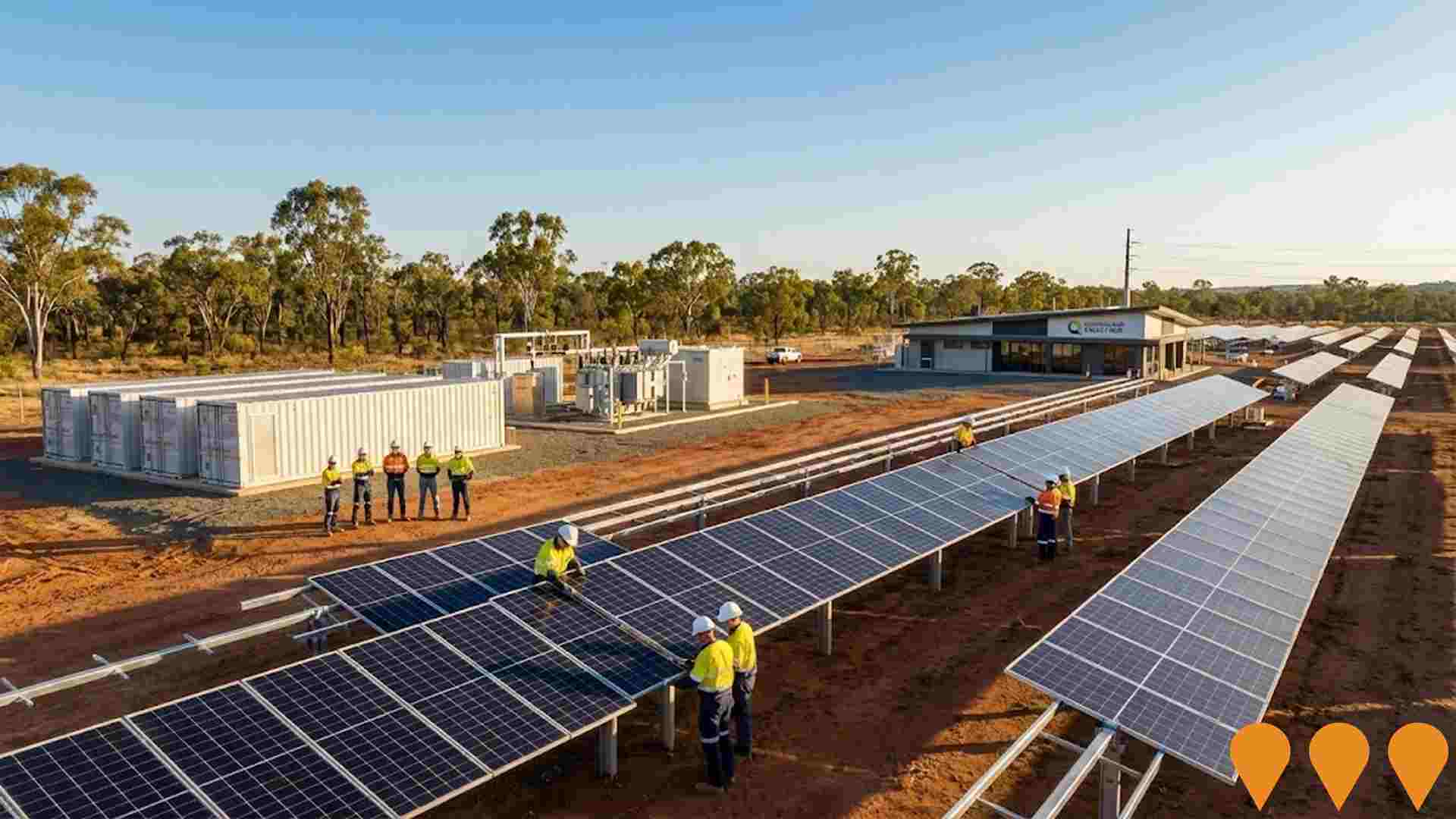
Moreton Bay Research Station
New world-class marine research and education facility on North Stradbroke Island focusing on Moreton Bay ecosystem health, climate change impacts, coral reef restoration, and sustainable fisheries. Joint initiative led by The University of Queensland in partnership with Queensland Government, Healthy Land and Water, and The Moreton Bay Foundation.

Brisbane to Gold Coast Transport Corridor Upgrades (Corridor Program)
A program of major transport upgrades along the Brisbane to Gold Coast corridor, incorporating multiple individual projects (such as the **Logan and Gold Coast Faster Rail** and the **Coomera Connector (M9)**) to enhance connectivity, reduce congestion, and support population growth. Components are at various stages, with key rail and road projects currently in **Construction** and **Planning** phases.
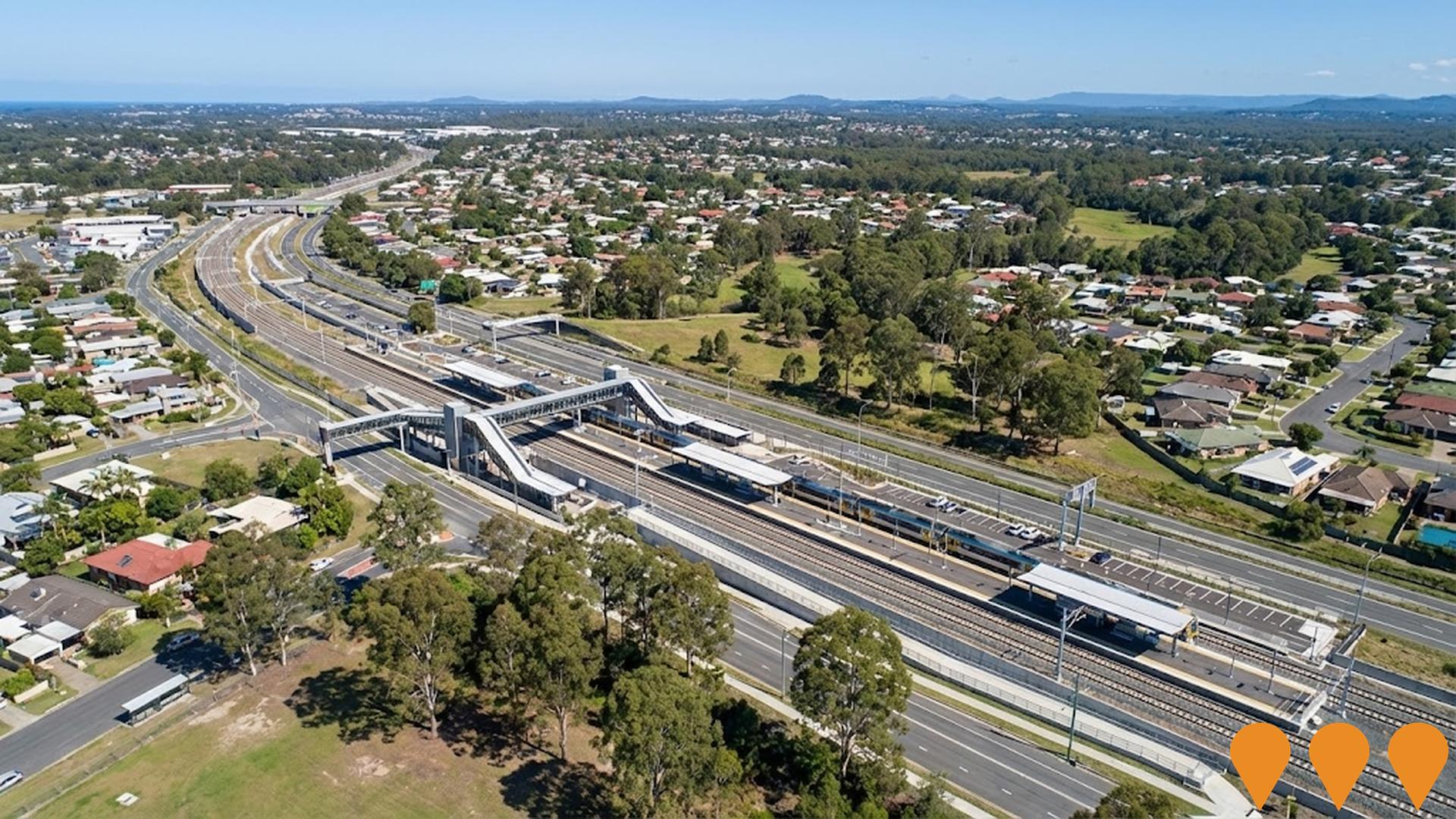
South East Queensland Infrastructure Plan and Supplement (SEQIP & SEQIS)
The South East Queensland Infrastructure Plan (SEQIP) and its accompanying Infrastructure Supplement (SEQIS) provide the strategic framework for infrastructure coordination across the SEQ region to 2046. The SEQIS specifically identifies priority infrastructure initiatives to support housing supply, economic growth and the delivery of the Brisbane 2032 Olympic and Paralympic Games, including transport, social infrastructure, and catalytic development projects.
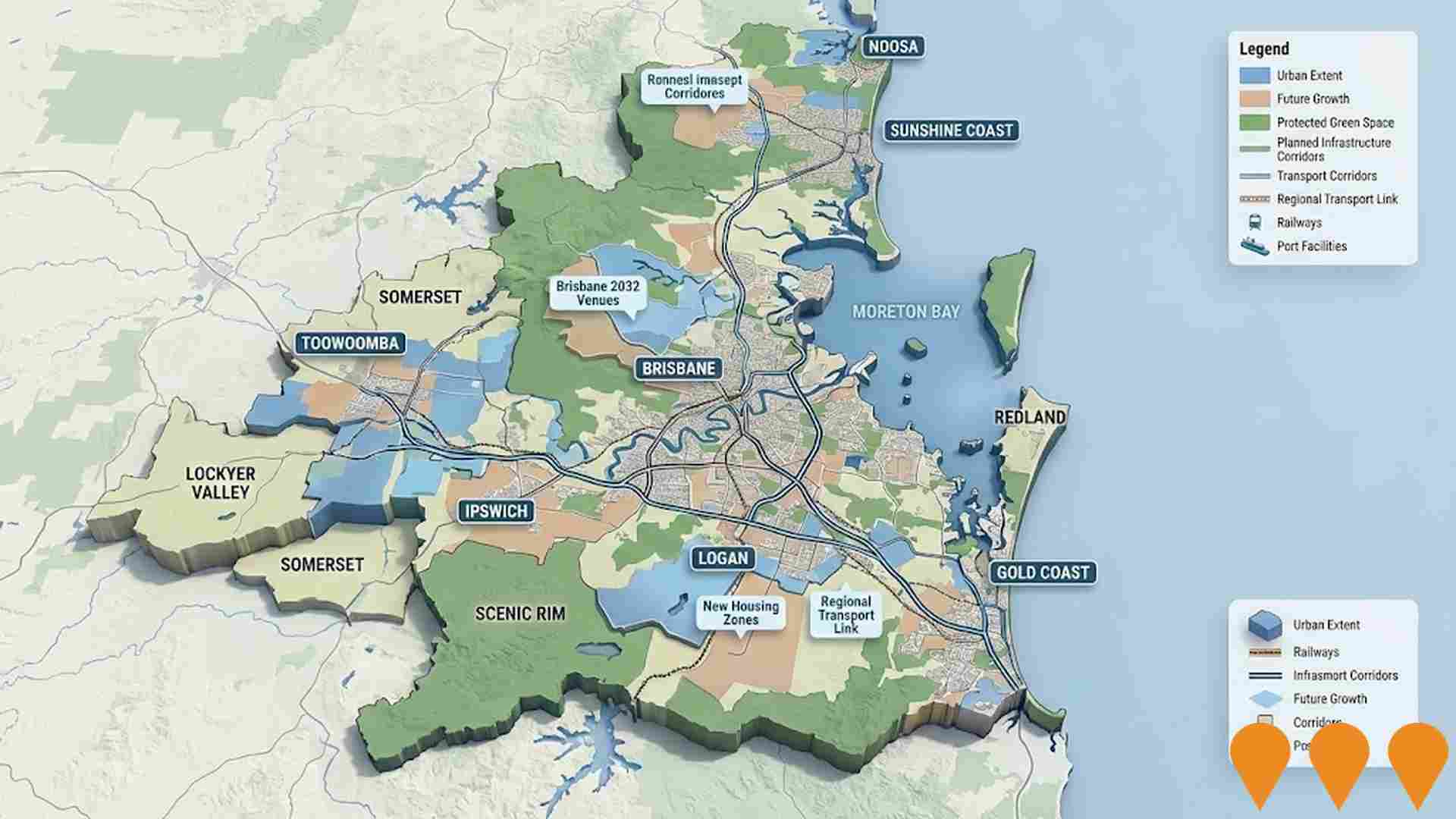
Logan Plan
The Logan Plan is Logan City Council's new city-wide planning scheme replacing the existing 2015 scheme. It will guide future growth, housing diversity, employment, and infrastructure across the entire City of Logan to 2046. The draft Logan Plan completed State Interest Review in June 2025 and underwent public consultation from 1 September to 31 October 2025. Council is now reviewing submissions with adoption and commencement targeted for mid-2026.
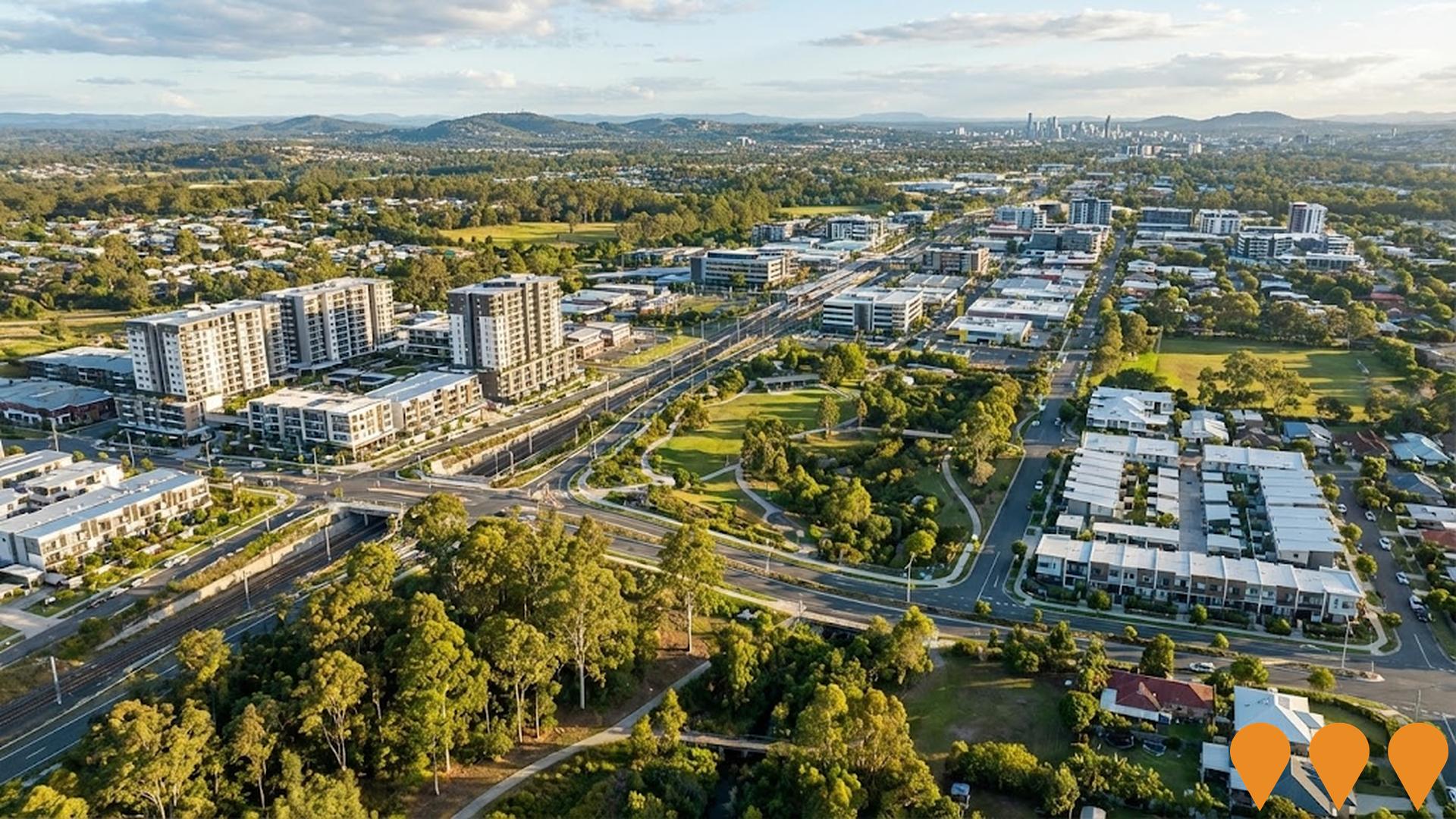
Building Future Hospitals Program
Queensland's flagship hospital infrastructure program delivering over 2,600 new and refurbished public hospital beds by 2031-32. Includes major expansions at Ipswich Hospital (Stage 2), Logan Hospital, Princess Alexandra Hospital, Townsville University Hospital, Gold Coast University Hospital and multiple new satellite hospitals and community health centres.

Cleveland Line Duplication (Park Road to Cleveland)
Major upgrade and partial duplication of the Cleveland Line between Park Road and Cleveland stations to increase capacity, improve reliability and enable higher frequency services in preparation for Cross River Rail and the Brisbane 2032 Olympic and Paralympic Games. Works include track duplication (particularly between Lindum and Cleveland), station upgrades, level crossing removals and signalling improvements.
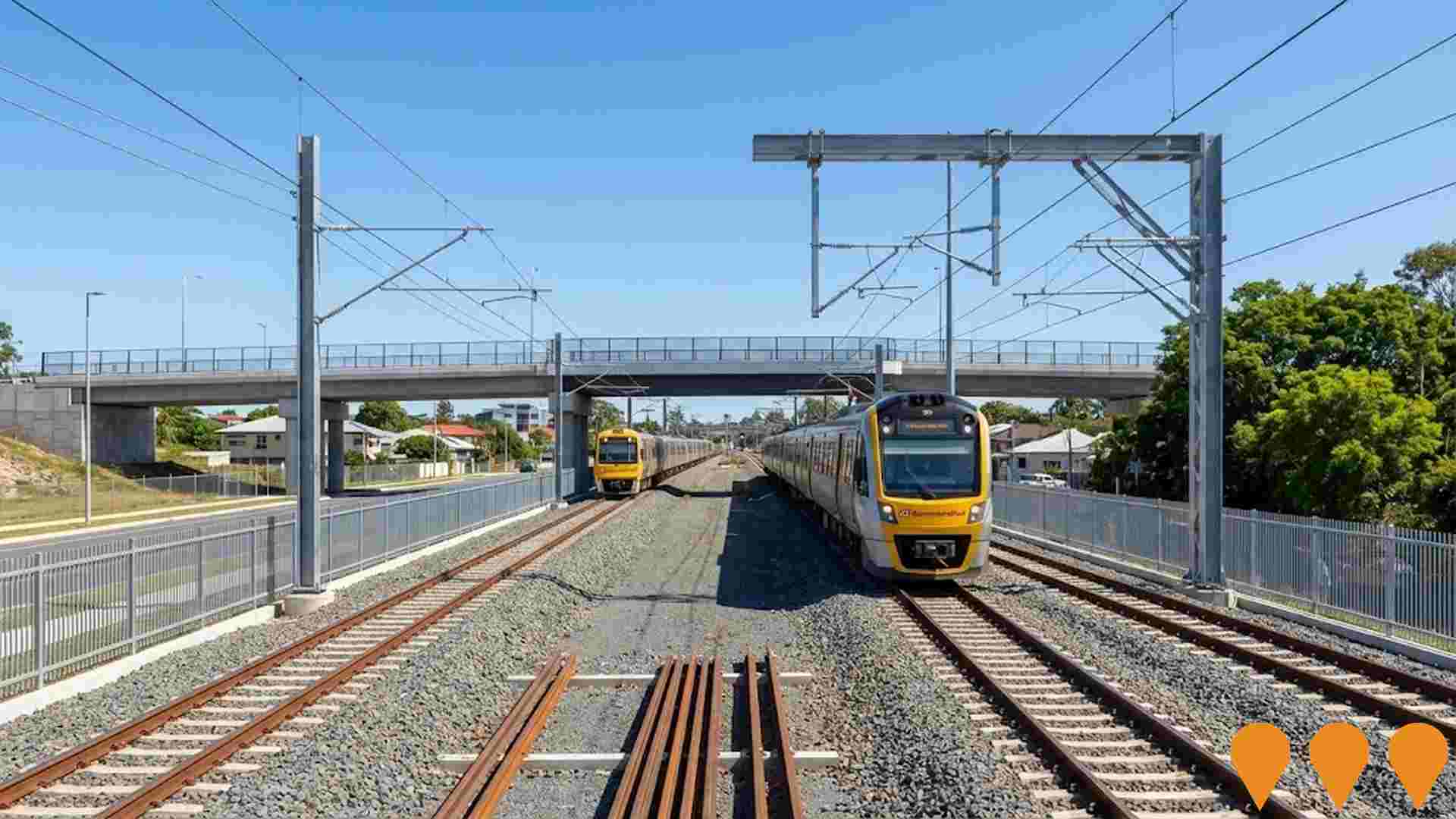
Employment
AreaSearch analysis reveals North Stradbroke Island recording weaker employment conditions than most comparable areas nationwide
North Stradbroke Island has a skilled workforce with tourism and hospitality sectors prominently featured. The unemployment rate is 6.3% and there was an estimated employment growth of 4.5% over the past year.
As of June 2025, 1,053 residents are employed while the unemployment rate is 2.2% higher than Greater Brisbane's rate of 4.1%. Workforce participation on the island lags significantly at 48.5%, compared to Greater Brisbane's 64.5%. Key industries of employment among residents include accommodation & food, health care & social assistance, and construction. The area has a notably high concentration in accommodation & food, with employment levels at 2.9 times the regional average.
However, health care & social assistance is under-represented, with only 10.2% of North Stradbroke Island's workforce compared to 16.1% in Greater Brisbane. The area appears to offer limited local employment opportunities, as indicated by the count of Census working population vs resident population. Over the 12 months to June 2025, employment increased by 4.5%, while labour force increased by 4.6%, with unemployment remaining essentially unchanged. In comparison, Greater Brisbane saw employment grow by 4.4%, labour force expand by 4.0%, and unemployment fall by 0.4 percentage points. Jobs and Skills Australia's national employment forecasts from May 2025 suggest potential future demand within North Stradbroke Island. These projections estimate national employment growth of 6.6% over five years and 13.7% over ten years, with significant variations between industry sectors. Applying these projections to North Stradbroke Island's employment mix suggests local growth of approximately 6.0%% over five years and 12.6% over ten years.
Frequently Asked Questions - Employment
Income
Income metrics place the area in the bottom 10% of locations nationally according to AreaSearch analysis
AreaSearch's latest postcode level ATO data for financial year 2022 shows North Stradbroke Island's median income among taxpayers is $39,868. The average income is $55,485. This is below the national average. In comparison, Greater Brisbane has a median income of $55,645 and an average of $70,520. Based on Wage Price Index growth of 13.99% since financial year 2022, current estimates suggest approximately $45,446 as the median income and $63,247 as the average income by September 2025. Census data indicates that household, family, and personal incomes in North Stradbroke Island fall between the 10th and 18th percentiles nationally. Income brackets show that 26.5% of locals (623 people) predominantly earn within the $1,500 - $2,999 category, which is consistent with broader trends across the broader area showing 33.3% in the same category. Housing affordability pressures are severe on North Stradbroke Island, with only 84.6% of income remaining after housing costs, ranking at the 12th percentile nationally.
Frequently Asked Questions - Income
Housing
North Stradbroke Island is characterized by a predominantly suburban housing profile, with above-average rates of outright home ownership
North Stradbroke Island's dwellings, as per the latest Census, were 83.9% houses and 16.1% other dwellings (semi-detached, apartments, 'other' dwellings). This is similar to Brisbane metro's dwelling structure of 83.9% houses and 16.1% other dwellings. Home ownership on North Stradbroke Island was at 49.0%, with mortgaged dwellings at 23.1% and rented ones at 27.9%. The median monthly mortgage repayment in the area was $1,733, lower than Brisbane metro's average of $2,000. The median weekly rent figure on North Stradbroke Island was $300, compared to Brisbane metro's $425. Nationally, North Stradbroke Island's mortgage repayments were below the Australian average of $1,863, and rents were substantially lower than the national figure of $375.
Frequently Asked Questions - Housing
Household Composition
North Stradbroke Island features high concentrations of lone person households, with a lower-than-average median household size
Family households constitute 63.4% of all households, including 18.5% couples with children, 34.6% couples without children, and 10.1% single parent families. Non-family households comprise the remaining 36.6%, with lone person households at 32.8% and group households making up 3.7%. The median household size is 2.1 people, which is smaller than the Greater Brisbane average of 2.6.
Frequently Asked Questions - Households
Local Schools & Education
North Stradbroke Island faces educational challenges, with performance metrics placing it in the bottom quartile of areas assessed nationally
Educational qualifications on North Stradbroke Island lag behind regional benchmarks. 24.8% of residents aged 15 and over hold university degrees, compared to 30.5% in Greater Brisbane. Bachelor degrees are the most common at 16.0%, followed by postgraduate qualifications (6.0%) and graduate diplomas (2.8%). Vocational credentials are also prevalent, with 41.5% of residents aged 15 and over holding them - advanced diplomas (10.9%) and certificates (30.6%).
A significant 24.0% of the population is actively pursuing formal education, including 10.1% in primary education, 8.2% in secondary education, and 2.2% in tertiary education. Dunwich State School serves North Stradbroke Island, with an enrollment of 144 students as of 2021. The island has varied educational conditions, with one school focusing exclusively on primary education and secondary options available in nearby areas. Local school capacity is limited, with 6.1 places per 100 residents compared to the regional average of 14.4, leading many families to travel for schooling.
Frequently Asked Questions - Education
Schools Detail
Nearby Services & Amenities
Transport
Transport servicing is low compared to other areas nationally based on assessment of service frequency, route connectivity and accessibility
North Stradbroke Island has 39 active public transport stops, all of which are bus stops. These stops are served by two routes that together provide 259 weekly passenger trips. The island's transport accessibility is rated as good, with residents typically located 325 meters from the nearest stop.
On average, there are 37 trips per day across all routes, equating to approximately six weekly trips per stop.
Frequently Asked Questions - Transport
Transport Stops Detail
Health
Health performance in North Stradbroke Island is well below average with prevalence of common health conditions notable across both younger and older age cohorts
Health data indicates significant challenges for North Stradbroke Island's population regarding common health conditions, affecting both younger and older age groups. Approximately 48% of the island's total population (~1,120 people) has private health cover, which is lower compared to Greater Brisbane's 54.2% and the national average of 55.3%. The most prevalent medical conditions are arthritis (10.0%) and mental health issues (8.3%).
Conversely, 62.1% of residents report having no medical ailments, slightly lower than Greater Brisbane's 64.6%. The island has a higher proportion of seniors aged 65 and over at 33.8% (794 people), compared to Greater Brisbane's 25.3%. Notably, health outcomes among seniors on the island are strong, outperforming the general population in several health metrics.
Frequently Asked Questions - Health
Cultural Diversity
North Stradbroke Island is considerably less culturally diverse than average when assessed alongside AreaSearch's national rankings for language and cultural background related metrics
North Stradbroke Island, surveyed in June 2016, showed low cultural diversity with 85.2% citizens, 86.1% born in Australia, and 96.1% speaking English only at home. Christianity was the dominant religion, comprising 45.0%. Buddhism was overrepresented at 1.9%, compared to Greater Brisbane's 1.0%.
Top ancestry groups were English (29.0%), Australian (22.6%), and Australian Aboriginal (11.0%), significantly higher than regional averages. Scottish (10.4%) and Irish (10.3%) were notably overrepresented, while French was at 0.7%.
Frequently Asked Questions - Diversity
Age
North Stradbroke Island ranks among the oldest 10% of areas nationwide
North Stradbroke Island has a median age of 52 years, which is notably higher than Greater Brisbane's median age of 36 years, and also older than the national norm of 38 years. Compared to the Greater Brisbane average, the 65-74 age cohort is notably over-represented on North Stradbroke Island at 19.8%, while the 25-34 age cohort is under-represented at 6.8%. This concentration of the 65-74 age group is well above the national average of 9.4%. Between 2021 and present, the 75 to 84 age group has grown from 8.6% to 11.9% of the population, while the 15 to 24 age cohort increased from 8.1% to 9.6%. Conversely, the 55 to 64 age cohort has declined from 17.3% to 14.4%, and the 5 to 14 age group dropped from 10.5% to 9.5%. Demographic modeling suggests that North Stradbroke Island's age profile will evolve significantly by 2041. The 75 to 84 age cohort is projected to expand by 128 people (46%), from 280 to 409. Notably, the combined 65+ age groups are expected to account for 100% of total population growth, reflecting the area's aging demographic profile. In contrast, population declines are projected for the 45 to 54 and 55 to 64 age cohorts.

